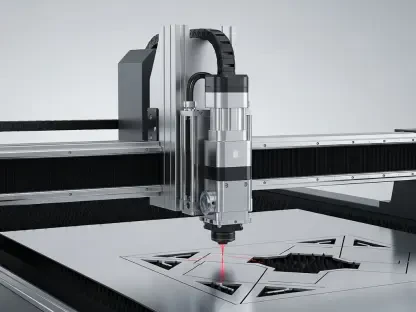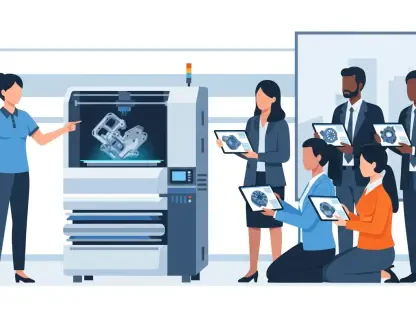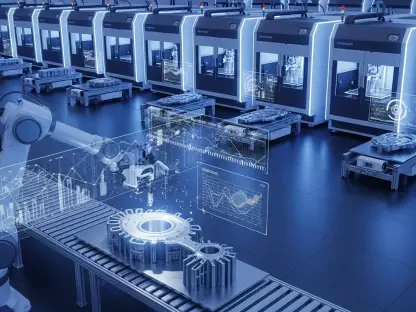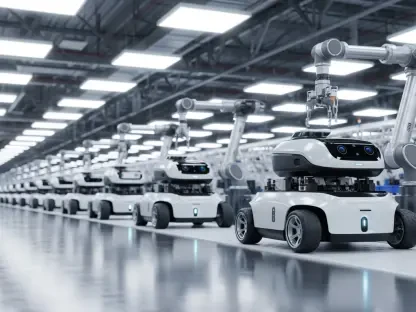Researchers from Pennsylvania State University (PSU) are spearheading a groundbreaking project in collaboration with Michigan State University (MSU), Massachusetts Institute of Technology (MIT), and the University of Southern California (USC). This ambitious initiative aims to revolutionize high-performance ceramic production by leveraging advanced 3D printing techniques. Titled “Photochemical and Photothermal Additive Manufacturing of Preceramic Polymers,” the project has garnered significant attention and support, including a $4.5 million grant from the U.S. Department of Defense (DoD) through the Office of Naval Research (ONR).
The significance of this effort cannot be overstated, as it represents a major step forward in the efficient and accurate manufacturing of ceramics critical to the aerospace and defense sectors. Traditional methods often require extremely high temperatures, leading to substantial material loss and geometric distortions. By opting for high-intensity lasers to induce chemical reactions that densify preceramic polymers into hardened ceramics without bulk heating, this innovative approach promises to be faster, more accurate, and highly energy-efficient.
Project Leadership and Key Contributors
Leading this cutting-edge research are Robert Hickey, an Associate Professor of Materials Science and Engineering at PSU, and Michael Hickner, a Professor at MSU. Their team includes notable experts like Benjamin Lear, Professor of Chemistry at PSU, and Co-Principal Investigators Adri van Duin and Jon-Paul Maria at PSU. From USC, Priya Vashishta and Aiichiro Nakano bring their expertise to the table, alongside Alexander Radosevich from MIT. Together, they form a powerhouse of knowledge aiming to push the boundaries of ceramic manufacturing.
The collaborative effort underscores the multidisciplinary nature of this project, drawing on insights from chemistry, materials science, and engineering. These researchers are primarily focused on developing new polymer precursors, leveraging light-based ceramic conversion, and utilizing computational simulations to optimize material design. Their combined expertise covers every aspect of the research, from fundamental chemistry and material synthesis to advanced engineering applications, making this project a holistic approach to solving long-standing challenges in ceramic manufacturing.
Objectives and Methodology
The primary objective of this innovative research is to bypass traditional ceramic manufacturing processes that often involve extremely high temperatures, leading to substantial material loss and geometric distortions. In conventional methods, up to 50% of the material can be lost during the heating process. With new techniques involving high-intensity lasers, the team aims to induce chemical reactions that rapidly densify preceramic polymers, converting them into hardened ceramics without bulk heating.
This novel approach promises faster, more accurate, and energy-efficient 3D printing of high-performance ceramics. The research lays the groundwork for overcoming existing manufacturing challenges, ensuring that the final products not only meet but exceed current performance standards. By employing these advanced techniques, the team aims to revolutionize the way ceramics are produced, offering a practical alternative to traditional methods that are often inefficient and wasteful.
Importance of High-Performance Ceramics
High-performance ceramics are indispensable in various sectors, especially in aerospace and defense. These materials must withstand extreme temperatures and harsh environments, making them crucial for the development of hypersonic vehicles. The ability to 3D print intricate ceramic components vastly expands design possibilities, potentially enhancing the performance and efficiency of advanced aerospace systems.
The utility of these ceramics extends beyond aerospace, impacting other spheres such as energy production and industrial manufacturing. Their robustness and durability make them excellent candidates for applications requiring resilient materials capable of enduring extreme conditions. This broad applicability underscores the far-reaching impact of advancements in ceramic 3D printing, which could pave the way for new innovations across multiple industries, providing solutions to complex engineering challenges.
Integrating Experiments with Computational Simulations
A defining feature of this project is its dual approach, integrating experimental work with computational simulations. Initial experiments feed data into computational models designed to predict the behavior of new preceramic polymers processed with light-based methods. These models, in turn, guide subsequent experiments, creating a valuable feedback loop that refines material design and optimizes manufacturing processes.
This methodology not only accelerates the development of new ceramics but also ensures a higher degree of predictability and reliability in the production process. By streamlining the research loop, the team can iterate quickly, moving from prototype to final product with greater efficiency. This integrated approach demonstrates the potential for advanced computational models to transform experimental sciences, making research more agile and responsive to emerging challenges.
Significant Implications for Defense and Aerospace
Ceramics that can endure ultra-high temperatures are essential in defense and aerospace applications. Innovations in 3D printing methods promise to streamline the production of these materials, enabling the creation of complex shapes that were previously difficult or impossible to manufacture. Additionally, the research team is developing computational tools to predict the formation of intermediates during ceramic production, further refining the manufacturing process.
The implications for defense are significant. Hypersonic vehicles, which travel at speeds greater than Mach 5, require materials that can withstand intense thermal and mechanical stresses. The successful development of these high-performance ceramics could play a critical role in advancing national defense capabilities. Moreover, the streamlined production process could lead to faster deployment of new technologies, keeping defense systems at the cutting edge of innovation and enhancing national security.
Exploring Various High-Temperature Ceramics
Adri van Duin, one of the key researchers, pointed out that the project will explore additive manufacturing techniques for a range of high-temperature ceramics. These include tungsten carbide and silicon-based ceramics like silicon carbide and silicon nitride. Known for their impressive durability in extreme conditions, these materials hold substantial potential for various industrial applications, from turbine blades to heat shields.
This exploration isn’t just limited to one type of ceramic. By investigating a variety of materials, the team aims to broaden the scope of their findings, potentially leading to multi-faceted applications across different industries. The diverse range of materials studied ensures that the research has wide applicability, addressing multiple needs and opening up new possibilities for the use of high-performance ceramics in various technological domains.
Other Advancements in Ceramic 3D Printing Technologies
While PSU’s project is groundbreaking, it’s not the only advancement in the field of ceramic 3D printing. Recently, D3-AM introduced its innovative Micro-Particle Jetting (MPJ) technology at the Formnext 2023 conference. This technology addresses the limitations of traditional inkjet systems by allowing the drop-by-drop construction of complex ceramic components, specifically targeting materials such as alumina and sintered silicon carbide (SSiC). Stefan Waldner, Chief Product Officer at D3-AM, highlighted MPJ’s potential impact on manufacturing in sectors such as aerospace and energy, offering a new method to print water-based suspensions with varying particle sizes.
Meanwhile, other initiatives are also contributing significantly to the field. Cornell University, Dimensional Energy, and Lithoz have received a $50,000 grant to develop new ceramics for 3D printing parts of clean energy reactors. This project aims to create ceramics capable of enduring high temperatures in thermocatalytic reactors, enhancing resilience and improving CO2 conversion rates. Utilizing computer modeling and 3D printing, the team intends to optimize reactor part designs to support clean energy production and fortify supply chain resilience in the U.S.
Broader Trends and Future Outlook
The ongoing advancements in high-performance ceramic 3D printing highlight several key trends and future possibilities. First, there is a clear shift towards leveraging advanced manufacturing techniques to reduce energy consumption and improve precision. The use of high-intensity lasers to eliminate the need for bulk heating exemplifies this trend, as it directly addresses the inefficiencies associated with traditional ceramic production methods.
Second, there is an emphasis on creating integrated systems that combine experimental results with computational models. This approach not only accelerates the development of new materials but also enhances the predictability and reliability of the manufacturing processes. The ability to quickly iterate between experiments and simulations offers a powerful advantage, allowing researchers to fine-tune their methods and materials in response to real-time data.
Third, the research underscores the growing importance of high-performance ceramics in critical industries such as aerospace, defense, and clean energy. As these sectors continue to demand materials that can withstand extreme conditions, innovations in ceramic 3D printing will play an increasingly vital role in meeting these needs. The resilience and efficiency of high-performance ceramics make them a strategic asset in these industries, where reliability and performance are paramount.
Finally, collaborations across universities and research institutions demonstrate the multidisciplinary nature of this field. By bringing together experts from various domains, these partnerships foster a comprehensive understanding of the challenges and opportunities in ceramic 3D printing. This collective approach enhances the scope and depth of the research, paving the way for groundbreaking discoveries and innovative solutions to complex engineering problems.
Conclusion
Researchers from Pennsylvania State University (PSU) have teamed up with Michigan State University (MSU), Massachusetts Institute of Technology (MIT), and the University of Southern California (USC) to spearhead a revolutionary project. This initiative aims to transform high-performance ceramic production using cutting-edge 3D printing techniques. Named “Photochemical and Photothermal Additive Manufacturing of Preceramic Polymers,” the project has captured widespread attention and secured a $4.5 million grant from the U.S. Department of Defense (DoD) via the Office of Naval Research (ONR).
This effort is monumental for the aerospace and defense sectors, marking a significant leap in the efficient and precise manufacturing of ceramics. Conventional methods typically require very high temperatures, resulting in considerable material waste and geometric distortions. By using high-intensity lasers to trigger chemical reactions that densify preceramic polymers into hardened ceramics without extensive heating, this pioneering method aims to be faster, more accurate, and extremely energy-efficient. This project could set new standards for ceramic manufacturing, thereby enhancing its applications in critical fields.









